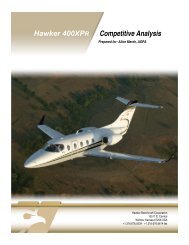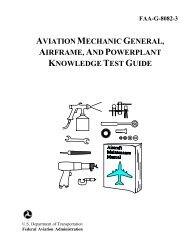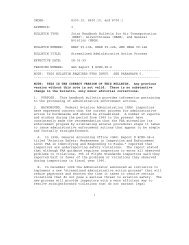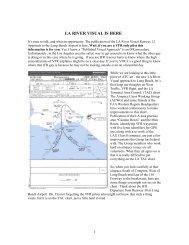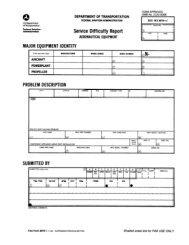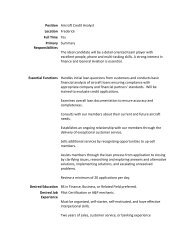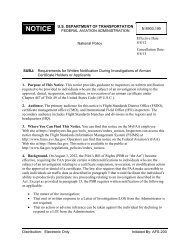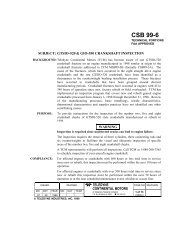2008 Nall Report - Aircraft Owners and Pilots Association
2008 Nall Report - Aircraft Owners and Pilots Association
2008 Nall Report - Aircraft Owners and Pilots Association
You also want an ePaper? Increase the reach of your titles
YUMPU automatically turns print PDFs into web optimized ePapers that Google loves.
takeoff<br />
Stalled during<br />
<strong>2008</strong> NALL climb REPORT<br />
11 (6.8%)<br />
8 (26.7%)<br />
Fatal<br />
Loss of control<br />
9 (30.0%)<br />
69 (42.6%)<br />
Weight/density<br />
altitude<br />
Accident conditions<br />
Runway<br />
17 (10.5%)<br />
1 (3.3%) Factors: Flight Planning <strong>and</strong><br />
Decision Making 24 (14.8%)<br />
Other<br />
2 (6.7%)<br />
5 (16.7%)<br />
19 (11.7%)<br />
0 10 20 30 40 50 60 70 80<br />
VFR into IMC<br />
IFR technique<br />
This <strong>and</strong> the following two sections of the <strong>Nall</strong> <strong>Report</strong><br />
examine the pilot-related causal factors of GA<br />
accidents in more detail. The discussion of each<br />
factor presents detailed information on pilot qualifications<br />
<strong>and</strong> experience, aircraft class, type of operation,<br />
<strong>and</strong> typical types of accidents experienced<br />
for each factor. Representative accident case studies<br />
are presented throughout.<br />
This first section focuses on factors that are related<br />
to pilot planning <strong>and</strong> decision<br />
11 (22.0%)<br />
making, <strong>and</strong> includes<br />
accidents related to fuel<br />
11<br />
management<br />
(26.8%)<br />
<strong>and</strong> weather.<br />
Fuel Management<br />
Thunderstorms<br />
90 total/9 fatal<br />
Turbulence<br />
Icing<br />
Other<br />
Flight<br />
planning<br />
Systems<br />
operation<br />
Contamination<br />
2 (4.9%)<br />
Total<br />
Fatal<br />
Most fuel-management accidents are the result of<br />
one of the 4 following (8.0%) reasons:<br />
2 (4.9%)<br />
5 (10.0%)<br />
4 (9.8%)<br />
4 (8.0%)<br />
24 (48.0%)<br />
• Flight Planning – Improper preflight planning<br />
2 (4.0%)<br />
resulting in insufficient fuel being on board for the<br />
1 (2.4%)<br />
planned flight, or inadequate in-flight monitoring<br />
of ground speed.<br />
0 5 10 15 20 25<br />
• Systems Operation – Improper operation of the<br />
fuel system leading to loss of fuel to the engine,<br />
even though fuel is available in at least one tank.<br />
Types of Fuel-Management Accidents<br />
3 (33.3%)<br />
4 (44.4%)<br />
2 (2.2%)<br />
2 (22.2%)<br />
22 (24.4%)<br />
66 (73.3%)<br />
21 (51.2%)<br />
Total<br />
Fatal<br />
0 10 20 30 40 50 60 70 80<br />
• Contamination – Use of fuel containing water,<br />
sediments, or other foreign substances that prevent<br />
proper operation of the engine.<br />
• Improper Fueling – Servicing of the aircraft<br />
with the wrong type of fuel, or adding the wrong<br />
amount of fuel even though preflight planning was<br />
accomplished correctly.<br />
Nearly three-quarters of the fuel management accidents<br />
(66) resulted from improper preflight planning<br />
(Figure 20). The systems operation category includes<br />
seven accidents, two of them fatal, caused by fuel<br />
line unporting due to aggressive maneuvering.<br />
Characteristics of Fuel-Management<br />
Accidents<br />
More than half (48 of 90, or 53.3 percent) occurred<br />
within five miles of an airport. They were not concentrated<br />
among inexperienced pilots: Half of the<br />
private pilots involved had more than 500 hours<br />
total time; three-quarters of the commercial pilots<br />
had more than 800 hours. At least three-quarters<br />
of the accident pilots at every certificate level had<br />
more than 20 hours of time in type, with median<br />
values of 166 hours among private pilots <strong>and</strong> 264<br />
for commercial pilots (but only 75 hours for ATPs).<br />
Fuel exhaustion (insufficient fuel on board) <strong>and</strong><br />
starvation (improper operation of the fuel system)<br />
accidents were not more common in the more<br />
complicated aircraft, but they were more likely to<br />
be fatal (Figure 21).<br />
<strong>Aircraft</strong> Involved in<br />
Fuel-Management Accidents<br />
All Accidents Fatal Accidents<br />
Single-engine fixed 65 (72.2%) 4 (44.4%)<br />
Single-engine retractable 15 (16.7%) 2 (22.2%)<br />
Multiengine 10 (11.1%) 3 (33.3%)<br />
Figure 21<br />
Note: The SEF figures include three accidents, two<br />
of them fatal, in seaplanes.<br />
Figure 20<br />
14 15



